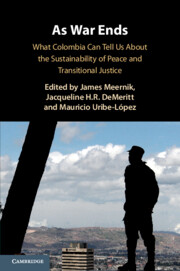Book contents
- As War Ends
- As War Ends
- Copyright page
- Contents
- Contributors
- Acknowledgments
- Introduction
- 1 The Complexity of the Organizational Design for Implementation of a Peace Accord
- 2 Violence, Grassroots Pressure, and Civil War Peace Processes
- 3 Land, Violence, and the Colombian Peace Process
- 4 Determinants of State Strength and Capacity
- 5 The Threat of Organized Crime in Post-Conflict Colombia
- 6 Violence after Peace
- 7 Two Emblematic Peacebuilding Initiatives in Antioquia
- 8 From Counterinsurgency to Peacebuilding
- 9 Transitional Justice in the Colombian Final Accord
- 10 The Comprehensive System of Truth, Justice, Reparation, and Non-Repetition
- 11 Una Tierra Inexplorada
- 12 Leading the Public to Peace
- 13 Securing the Peace and Promoting Human Rights in Post-Accord Colombia
- 14 Achieving an Unpopular Balance
- 15 Countering Violent Extremism through Narrative Intervention
- 16 Geographies of Truth in the Colombian Transitional Justice Process
- 17 Conclusion
- Index
- References
11 - Una Tierra Inexplorada
Gendering the Peace Process in Colombia
Published online by Cambridge University Press: 18 July 2019
- As War Ends
- As War Ends
- Copyright page
- Contents
- Contributors
- Acknowledgments
- Introduction
- 1 The Complexity of the Organizational Design for Implementation of a Peace Accord
- 2 Violence, Grassroots Pressure, and Civil War Peace Processes
- 3 Land, Violence, and the Colombian Peace Process
- 4 Determinants of State Strength and Capacity
- 5 The Threat of Organized Crime in Post-Conflict Colombia
- 6 Violence after Peace
- 7 Two Emblematic Peacebuilding Initiatives in Antioquia
- 8 From Counterinsurgency to Peacebuilding
- 9 Transitional Justice in the Colombian Final Accord
- 10 The Comprehensive System of Truth, Justice, Reparation, and Non-Repetition
- 11 Una Tierra Inexplorada
- 12 Leading the Public to Peace
- 13 Securing the Peace and Promoting Human Rights in Post-Accord Colombia
- 14 Achieving an Unpopular Balance
- 15 Countering Violent Extremism through Narrative Intervention
- 16 Geographies of Truth in the Colombian Transitional Justice Process
- 17 Conclusion
- Index
- References
Summary
Colombia is at a historic crossroads with the final approval of the second revised peace agreement between the Revolutionary Armed Forces of Colombia (FARC) and the government. While the peace process has progressed, the June 2018 election of Ivan Duque – the Democratic Center candidate seen as former president Alvaro Uribe’s hard-line protege – may generate challenges to the fragile peace. This issue – how to bring peace, justice, and reconciliation to post-conflict societies – is a central concern for the people of Colombia, for human rights activists and practitioners who want to end the culture of impunity, and for government and community leaders who need to build a society that is coming to terms with its past.
- Type
- Chapter
- Information
- As War EndsWhat Colombia Can Tell Us About the Sustainability of Peace and Transitional Justice, pp. 249 - 281Publisher: Cambridge University PressPrint publication year: 2019



